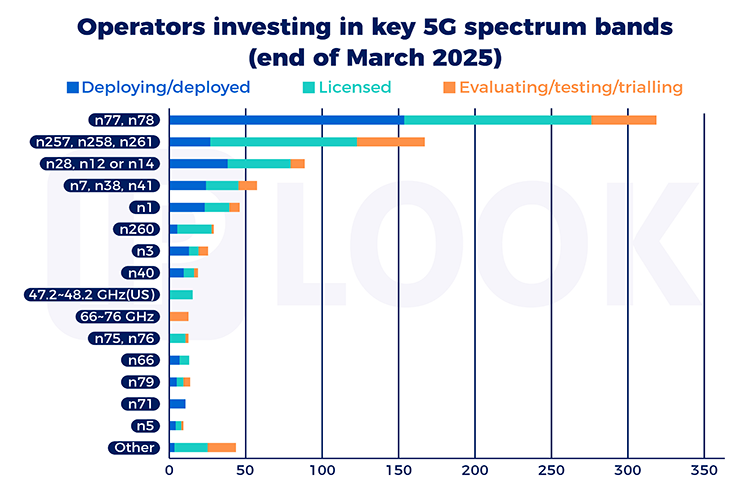
As 5G continues to expand worldwide, spectrum allocation has become one of the most critical factors shaping network deployment and device design. Unlike 2G or 3G—where a few frequency bands could support global roaming—the 5G era brings far greater complexity. Device manufacturers must now consider not only frequency bands but also NR Carrier Aggregation (CA) combinations, NSA/SA compatibility, and LTE-NR dual connectivity.
To better understand today’s 5G spectrum landscape, let’s explore two key perspectives:
Mainstream 5G frequency bands globally
Relatively unique or region-specific 5G frequency bands
Mainstream 5G Frequency Bands
Among the 354 commercial 5G operators worldwide, over 150 have deployed C-band (n77/n78). Since n78 is a subset of n77, these two are undoubtedly the most mainstream 5G bands globally.
Beyond C-band, another important group is the 700 MHz bands (n28/12/14). Although their bandwidth is relatively small, these FDD bands provide wide coverage and can be deployed alongside TDD bands for balanced performance. For example, operators in India have focused on n28 + n78, where n28 ensures nationwide coverage while n78 delivers high-capacity services.
Another widely adopted band is 2.6 GHz (n7/41/38). With both coverage and capacity advantages, this spectrum has been deployed at scale by major operators such as China Mobile and T-Mobile US, where n41 has become the primary 5G band.
The 2100 MHz band (n1) also plays a significant role. Originally used in 3G networks (WCDMA), many operators have refarmed this spectrum for 5G after shutting down legacy networks.
Interestingly, the mainstream bands in global deployments—n1, n28, n41, n78—are also the most important in China. Local regulators have planned these resources in a coordinated way: n28 and n41 are shared between China Mobile and China Broadcasting Network, while n1 and n78 are shared between China Telecom and China Unicom. This reflects China’s centralized spectrum strategy to maximize efficiency and nationwide coverage.
Unique and Region-Specific 5G Frequency Bands
While mainstream bands dominate global deployments, many regions also adopt special bands due to regulatory or market-driven factors. For example, some bands are newly released by governments for auction, while others are repurposed from 3G/4G spectrum.
One practical way to understand these differences is by studying global flagship smartphones that must support multiple markets. Apple’s iPhone is a prime example: it is sold worldwide in high volume through both operators and open channels, making it an industry benchmark for band design.
Taking the iPhone 16 series as an example:
All models share the same 5G frequency bands, from the standard version to Pro Max.
From iPhone 14 to iPhone 16, supported 5G bands remain consistent.
Apple’s design shows a global baseline set of frequency bands suitable for most regions, with incremental additions for specific markets:
Extra bands (n14, n29, n71) are included for countries like Canada, Japan, Mexico, Saudi Arabia, and others.
mmWave bands (n258/n260/n261) are only supported in the United States and Puerto Rico.
This approach illustrates how device makers balance global standardization with regional customization, ensuring both compatibility and cost efficiency.
Conclusion
5G spectrum is far more complex than previous generations, with diverse allocations across regions and continuous evolution in technology. While bands such as n77/n78, n28, n41, and n1 dominate globally, unique allocations in certain regions reflect local regulatory and market dynamics.
For network operators, vendors, and device manufacturers, understanding this spectrum landscape is essential to ensuring interoperability and delivering high-quality 5G experiences worldwide.
At IPLOOK, we remain committed to providing flexible, standards-compliant core network solutions that adapt seamlessly to different frequency bands and deployment scenarios—helping operators and enterprises unlock the full potential of 5G.

